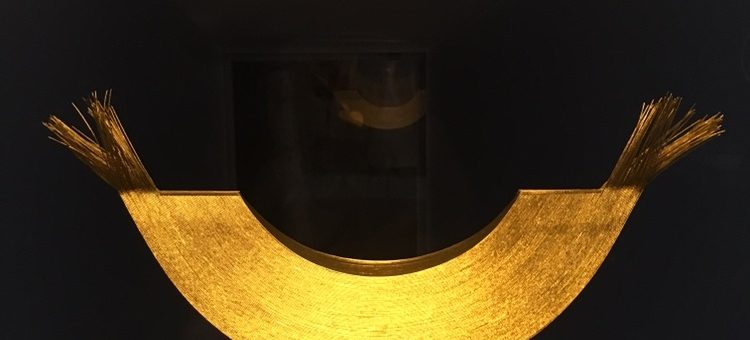
Oh! I Am Precious
- posted in: Uncategorized
Oh I Am Precious #7 Necklace-1986, MIZUHIKI (Paper Cord), Canvas.
Eugene Piganowski (American Born 1938), Hiroko Piganoswki (Japanes Born 1942)
Jewelry, The Body Transformed, Metropolitan Museum NYC
Hiroko Piganoswki, Biography
Hiroko Piganowski was born in Japan in 1942 and was raised by traditional Japanese parents. She studied with a renown Japanese painter in high school. She prepared herself for drawing and painting exams required for admission into a Japanese Art School. Hiroko waited for almost three years until she decided to continue her education and pursue a degree in art history. She later studied metal inlay techniques with Professor Tateo Unno. In preparation for her marriage (a traditional Japanese marriage), Hiroko started to select jewelry for her trousseau. She was appalled by the commercial jewelry available – it was this instance that directed her back to art. Hiroko learned there were no jewelry classes being taught at the best Japanese art schools. She decided to come to the United States to study jewelry and metalsmithing. Hiroko first went to California State University, Northridge and worked with Fred Lauritzen in 1964. Lauritzen challenged her to find out more about mokume gane (wood-grain metal). Hiroko found some information in a book that was written by Robert Von Neumann, The Design and Creation of Jewelry. This experienced urged her to study at Cranbrook Academy of Art.
Hiroko was admitted into Cranbrook in 1966. There she majored in jewelry and metalsmithing. She experimented in with soldered mokume gane. Her peers at Cranbrook (Fred Woell, Val Link and David LaPlantz) challenged her to learn more about metal techniques of her heritage. Hiroko made summer visits back to Japan and studied metal inlay techniques. Upon her return she started to incorporate these techniques into her jewelry and hollowware.
Hiroko met and married Euegene Piganowski while she was at Cranbrook Academy of Art. He was an influential figure in her life and they began to collaborate in their metalwork. In 1969 they traveled to Japan to learn more about Japanese metal techniques. They set up a studio in Yokohama and sold contemporary American style jewelry to support themselves. In Japan they saw a raised mokume pot in an exhibition. Both Eugene and Hiroko knew you could not raise a soldered mokume pot. They learned that the pot was raised from fused layers of metal. In 1973 they returned to the United States and were collaborating their metalwork. They explored and investigated the fused mokume gane technique. During a summer trip to Japan, they learned different patterns for mokume gane using copper and copper alloys.
Their research and work with mokume gane brought this ancient Japanese metalworking technique to America. Their contribution to the field is their work with mokume and their collaborative efforts as teachers and metalworkers. Their work is exhibited nationally and internationally.
(Temple edu.)
